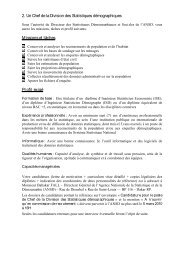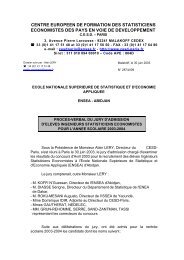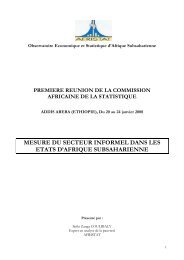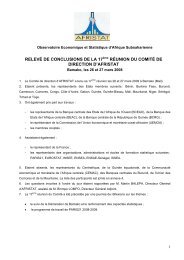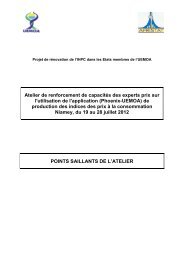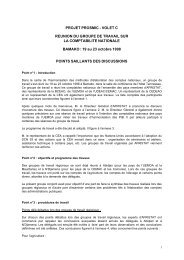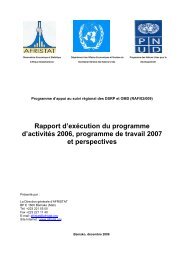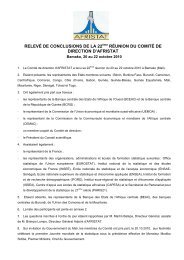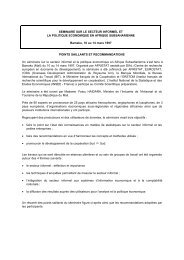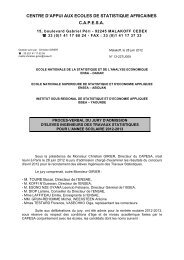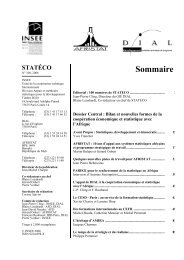Global Purchasing Power Parities and Real Expenditures - Afristat
Global Purchasing Power Parities and Real Expenditures - Afristat
Global Purchasing Power Parities and Real Expenditures - Afristat
You also want an ePaper? Increase the reach of your titles
YUMPU automatically turns print PDFs into web optimized ePapers that Google loves.
Glossary 207Multilateral comparison. A price or volume comparisonof more than two countries simultaneously that producesconsistent relations among all pairs of countries (that is, onethat satisfies the transitivity requirement).Net exports are the difference in value between the totalexports <strong>and</strong> total imports of an economy during a specificperiod of time.Net purchases from abroad. Purchases by resident householdsoutside the economic territory of the country, lesspurchases by nonresident households in the economic territoryof the country.NPISHs (nonprofit institutions serving households). Nonprofitinstitutions that are not predominantly financed <strong>and</strong>controlled by government, whose main resources are voluntarycontributions by households, <strong>and</strong> that provide goodsor services to households free or at prices that are not economicallysignificant.Numeraire currency. The term used for the currency unitselected to be the common currency in which PPPs <strong>and</strong>final expenditures on GDP (nominal <strong>and</strong> volumes) areexpressed. The numeraire is usually an actual currency(such as the U.S. dollar), but it can be an artificial currencyunit developed for the purposes of PPP comparisons.Other products. Products of agriculture, forestry, fisheries,<strong>and</strong> aquaculture, as well as software products.Per capita volumes. St<strong>and</strong>ardized measures of volume,which indicate the relative levels of the product groups oraggregates being compared, after adjusting for differencesin the size of populations between countries. At the levelof GDP, they are often used to compare the economic wellbeingof populations. They may be presented either in relationto a particular currency or as an index number.PLI (price level index) for a basic heading is the ratio of thebasic-heading PPP to the exchange rate. It is expressed asan index on a base of 100. A PLI that is greater than 100means that, when the national average prices are convertedat exchange rates, the resulting prices within the basicheading tend to be higher, on average, than prices in thebase country (or countries) of the region (<strong>and</strong> vice versa).At the level of GDP, they provide a measure of the differencesin the general price levels of countries. PLIs are alsoreferred to as “comparative price levels (CPLs).”Product specification. A description or list of the characteristicsthat can be used to identify a product selectedfor pricing. Its purpose is to ensure that countries pricecomparable items. A product specification can be eitherbr<strong>and</strong>- <strong>and</strong> model-specific (that is, a specification in whicha particular br<strong>and</strong> <strong>and</strong> model or a cluster of comparablebr<strong>and</strong>s [<strong>and</strong> possibly models] is stipulated) or generic (thatis, a specification where only the relevant price-determining<strong>and</strong> technical characteristics are given <strong>and</strong> no br<strong>and</strong> orcluster of br<strong>and</strong>s is designated.Productivity adjustment. An adjustment made to the pricespaid by nonmarket producers for labor, capital, <strong>and</strong> intermediateinputs so that they correspond to a common levelof multifactor productivity; in practice, an adjustmentmade to the prices (compensation of employees) paid bynonmarket producers for labor so that they represent thesame level of labor productivity.Products. Goods <strong>and</strong> services that are the result of production.They are exchanged <strong>and</strong> used for various purposes:as inputs in the production of other goods <strong>and</strong> services, asfinal consumption, or for investment. Also referred to as“goods <strong>and</strong> services,” “commodities,” or “items.”Purchaser’s price. Amount paid by the purchaser, excludingany deductible VAT or similar deductible tax, to takedelivery of a unit of a good or service at the time <strong>and</strong> placerequired by the purchaser; the purchaser’s price of a goodincludes any transport charges paid separately by the purchaserto take delivery at the required time <strong>and</strong> place.PPP (purchasing power parity) between two countries,A <strong>and</strong> B, is a price ratio that measures the number of unitsof country A’s currency that are needed in country A topurchase the same quantity of an individual good or serviceas one unit of country B’s currency will purchase incountry B.



